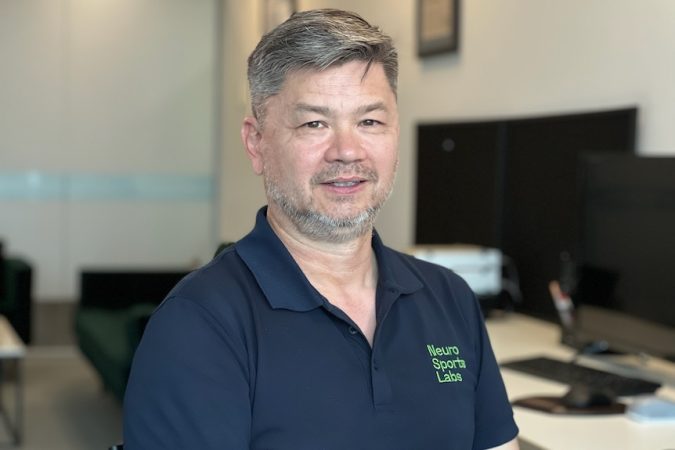
Inside a shed in an industrial estate on Melbourne’s outskirts, former AFL player Shaun Smith puts the finishing touches on a bespoke bedside table.
Key points:
- Paul McCrory’s research laid the foundation for the AFL’s current concussion guidelines
- The AFL investigated after he was accused of plagiarism and found some had occurred but it had not tainted his work
- Smith, who received a payout for injuries from years in AFL, said the AFL’s response came too late and players “felt cheated”
The sounds of the electric sander bouncing off the shed’s steel walls is noisy for some, but for Shaun it is a form of therapy.
“I basically just set this up to keep my brain active and be creative, some neuroplasticity,” said Smith, referring to the furniture-making venture he’s formed.
“I’ve got two choices: to sit at home and sort of cop what’s coming my way or front it head on, and this is one of the best things that I’ve done.”
The high-flying forward played 109 games for North Melbourne and Melbourne in the ’80s and ’90s and is perhaps best known for taking ‘Mark of the Century’ against the Brisbane Bears at The Gabba in 1995.
But repeated concussions during his playing career caused permanent brain damage, and his injuries led to an historic payout in 2020.
The 53-year-old has questioned findings released on Tuesday by the AFL after an investigation into controversial concussion consultant Associate Professor Paul McCrory.
A long-time adviser to the AFL, Dr McCrory’s research laid the foundation for the code’s current concussion guidelines.
But in March he quit as chair of the Concussion in Sport Group amid allegations of plagiarism.
This month the British Journal of Sports Medicine retracted nine of Dr McCrory’s articles and it says another 38 are “of concern”.
In a nutshell, the 260-page independent review, commissioned by the AFL in the wake of the plagiarism allegations, found while plagiarism had taken place it had not tainted Dr McCrory’s work with the AFL on concussion guidelines.
“Obviously if he’s been found to be fraudulent in one area, why has he been 100 per cent correct in another?” Smith said.
“When you see some of the stuff Paul McCrory comes up with, it’s not actually correct.”
Concussion researcher and neurophysiologist Alan Pearce said while a number of the plagiarised articles were not concussion-related, plagiarism was academic and scientific misconduct.
“We really need to address the fact that our experts are seen as that: experts,” Dr Pearce said.
“To be [exposed] as copying and cheating on work should be emphasised a little bit more.”
The plagiarism was “an embarrassing blemish on Associate Professor McCrory’s professional and academic reputation”, the review concluded.
The review also criticised the handling of a concussion research project that surveyed past players and was jointly run by the AFL and the Florey Institute.
It found the project was underfunded and under-resourced, and ultimately failed to produce any published research.
“We do apologise for people who gave up their time,” AFL general counsel Andrew Dillon said.
“They wanted to know more about their condition and we didn’t necessarily resource it as good as we should have or could have, but I think we’re in a position where we can fix that up.”
Smith calls on AFL to be more proactive in concussion research
Smith said the apology came too late — three years after the study finished in 2019 — and that players would “feel cheated”.
“[The AFL has] dragged their feet, clearly,” Smith said.
“They’ve finally worked out it was a complete waste of time. I think the AFL have just got to stop being reactive and be proactive.
“It’s like they’re trying to hide. They should just come out and go, ‘Yeah, we have an issue here and this is exactly what we’re going to do.’ But at the moment they’re just dodging bullets.”
Dr Pearce said he felt for the players and their families, who took part in the study “in good faith”.
“While an apology is nice, I think they need to go a little bit further in terms of completing the work,” he said.
Mr Dillon said the AFL would attempt to finish the past players study and publish its findings.
The findings of the McCrory investigation are handed down as America’s leading medical research group, the US National Institutes of Health (NIH), formally acknowledged a causal link between repeated head knocks and chronic traumatic encephalopathy (CTE).
The neurodegenerative disease was recently found in the brain of the late NRL player and coach Paul Green.
Concussion research advocates hoped the ruling by the NIH would inform a major concussion meeting in Amsterdam this week, attended by AFL officials, including the medical chief Michael Makdissi.
“I think in the last three to four years there has been so much movement in the science worldwide that they will need to react, and I hope that they react positively,” Dr Pearce said.
The AFL has provided a copy of the review to Judge John Cain, who is in charge of the coronial investigation into the death of former Richmond footballer Shane Tuck.
ABC Sport has contacted Dr McCrory via his lawyer for a response to the panel’s findings.
Source: AFL NEWS ABC



